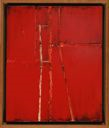Sam Gummelt does not have an image.
Sam Gummelt
American, (1944–2022)
Born in Waco in 1944, Sam Gummelt began his meteoric rise in 1970, as the first Texas artist to embrace the nascent international movement known as Minimalism, the austere, geometric successor to Abstract Expressionism and Pop Art. But Gummelt, the fourth generation descendent of German immigrants who farmed near Waco, gave Minimalism a uniquely regional, rural inflection, replacing the usual industrial finishes and fabrications with techniques such as quilting, woodworking and painting on glass, gleaned from his Texas frontier ancestors. He was noted for the painstaking craftsmanship of his work, "drawing" his trademark grids and diagonals with lines stitched by a sewing machine or incised by a saw; he would cut apart wooden panels and reassemble them into precise compositions covered with layers of wax or industrial paints, producing subtle, highly original colors, and lines that traced across the surfaces of his paintings in unpredictable paths. Gummelt's work was coveted by knowledgeable collectors, including the iconic New York gallerist Betty Parsons, who introduced America to Jackson Pollock and the Abstract Expressionists; legendary Dallas arts patron Betty Blake; and the late dean of Texas architects, Frank Welch, who was also a close personal friend. A graduate of North Texas State University (now the University of North Texas) and the Master of Fine Arts program at Southern Methodist University, Gummelt exhibited in numerous solo and group shows throughout the nation, including major one-person exhibitions at the Fort Worth Art Museum (now the Modern Art Museum of of Fort Worth) and the McKinney Avenue Contemporary in Dallas. Twice awarded National Endowment for the Arts fellowships, Gummelt is represented in a number of museum permanent collections, among them the Modern Art Museum of Fort Worth, the Dallas Museum of Art, and the Museum of Fine Arts, Houston. The literature on his work is extensive, including exhibition catalogs, major surveys of Texas art, and reviews in a wide range of newspapers and periodicals.
Source: The Dallas Morning News
American, (1944–2022)
Born in Waco in 1944, Sam Gummelt began his meteoric rise in 1970, as the first Texas artist to embrace the nascent international movement known as Minimalism, the austere, geometric successor to Abstract Expressionism and Pop Art. But Gummelt, the fourth generation descendent of German immigrants who farmed near Waco, gave Minimalism a uniquely regional, rural inflection, replacing the usual industrial finishes and fabrications with techniques such as quilting, woodworking and painting on glass, gleaned from his Texas frontier ancestors. He was noted for the painstaking craftsmanship of his work, "drawing" his trademark grids and diagonals with lines stitched by a sewing machine or incised by a saw; he would cut apart wooden panels and reassemble them into precise compositions covered with layers of wax or industrial paints, producing subtle, highly original colors, and lines that traced across the surfaces of his paintings in unpredictable paths. Gummelt's work was coveted by knowledgeable collectors, including the iconic New York gallerist Betty Parsons, who introduced America to Jackson Pollock and the Abstract Expressionists; legendary Dallas arts patron Betty Blake; and the late dean of Texas architects, Frank Welch, who was also a close personal friend. A graduate of North Texas State University (now the University of North Texas) and the Master of Fine Arts program at Southern Methodist University, Gummelt exhibited in numerous solo and group shows throughout the nation, including major one-person exhibitions at the Fort Worth Art Museum (now the Modern Art Museum of of Fort Worth) and the McKinney Avenue Contemporary in Dallas. Twice awarded National Endowment for the Arts fellowships, Gummelt is represented in a number of museum permanent collections, among them the Modern Art Museum of Fort Worth, the Dallas Museum of Art, and the Museum of Fine Arts, Houston. The literature on his work is extensive, including exhibition catalogs, major surveys of Texas art, and reviews in a wide range of newspapers and periodicals.
Source: The Dallas Morning News
Artist Objects
Little Red 2014.002
